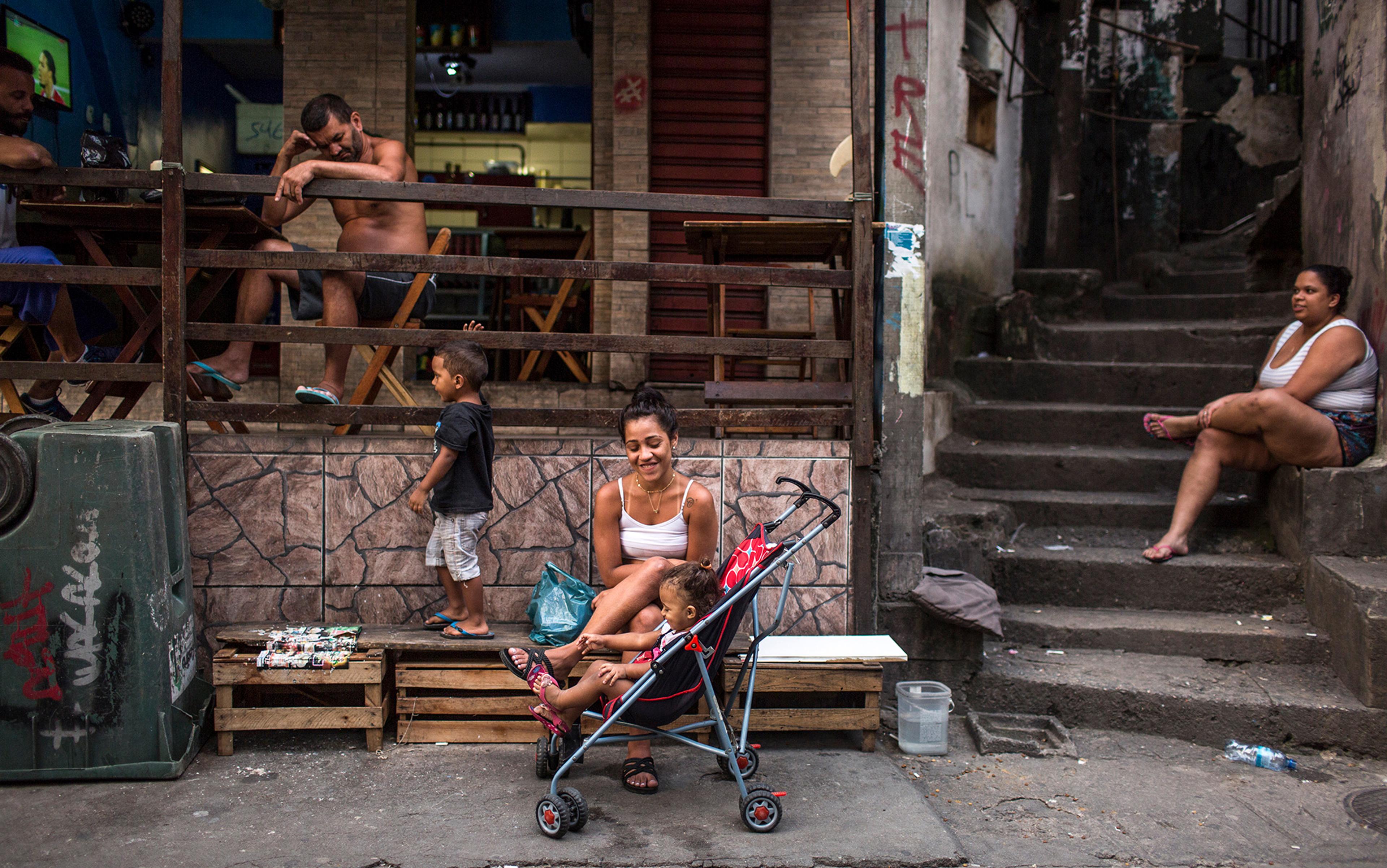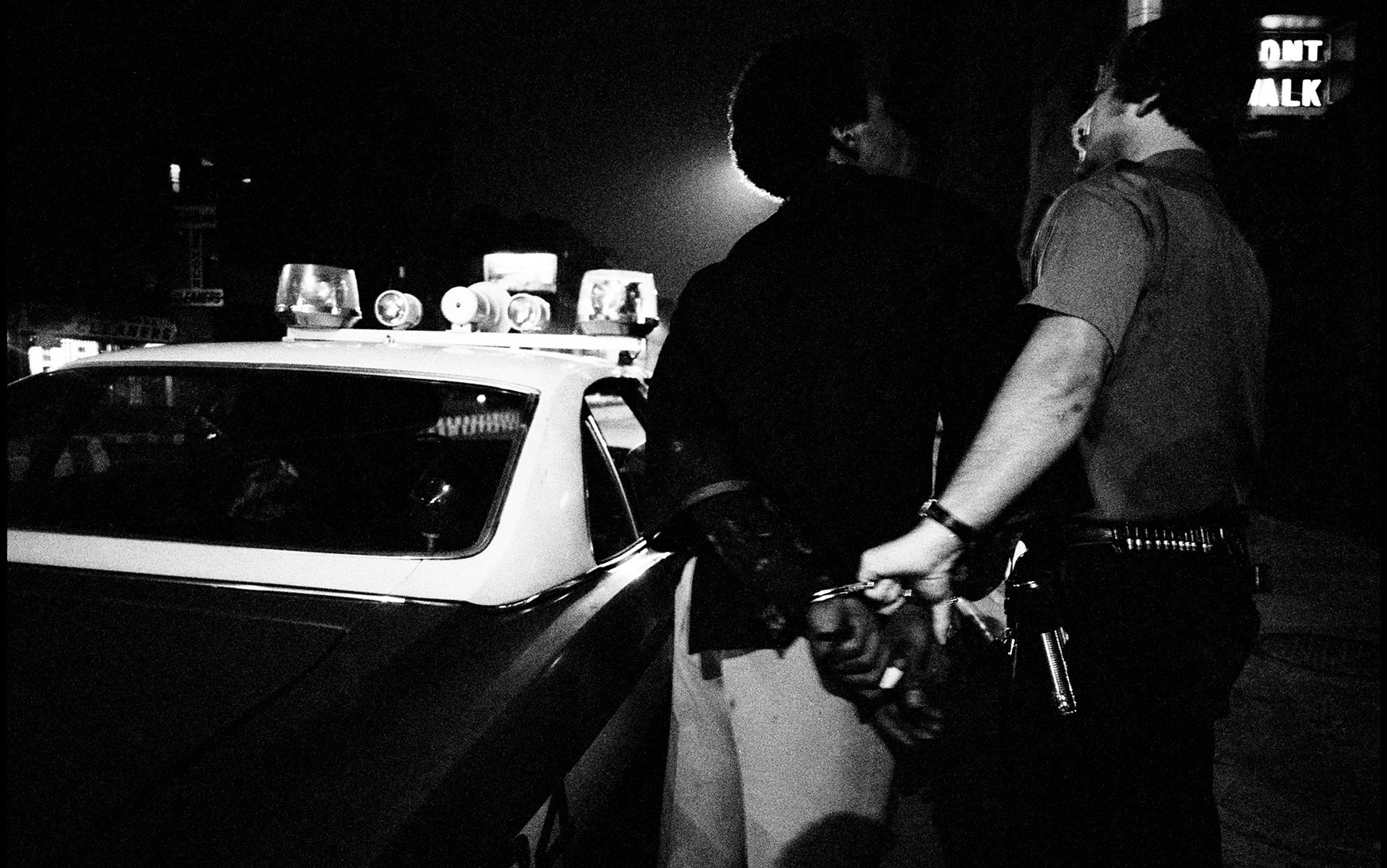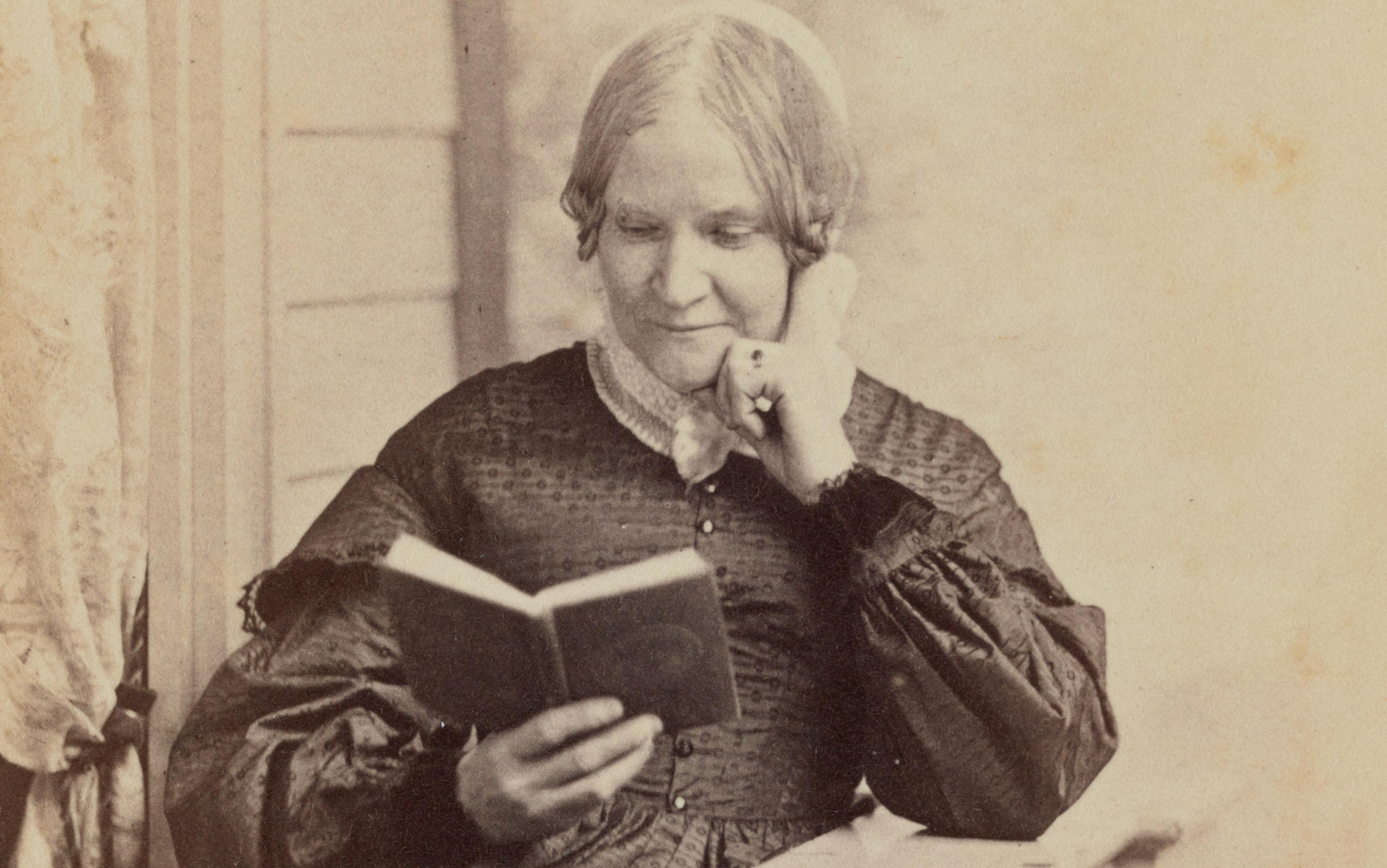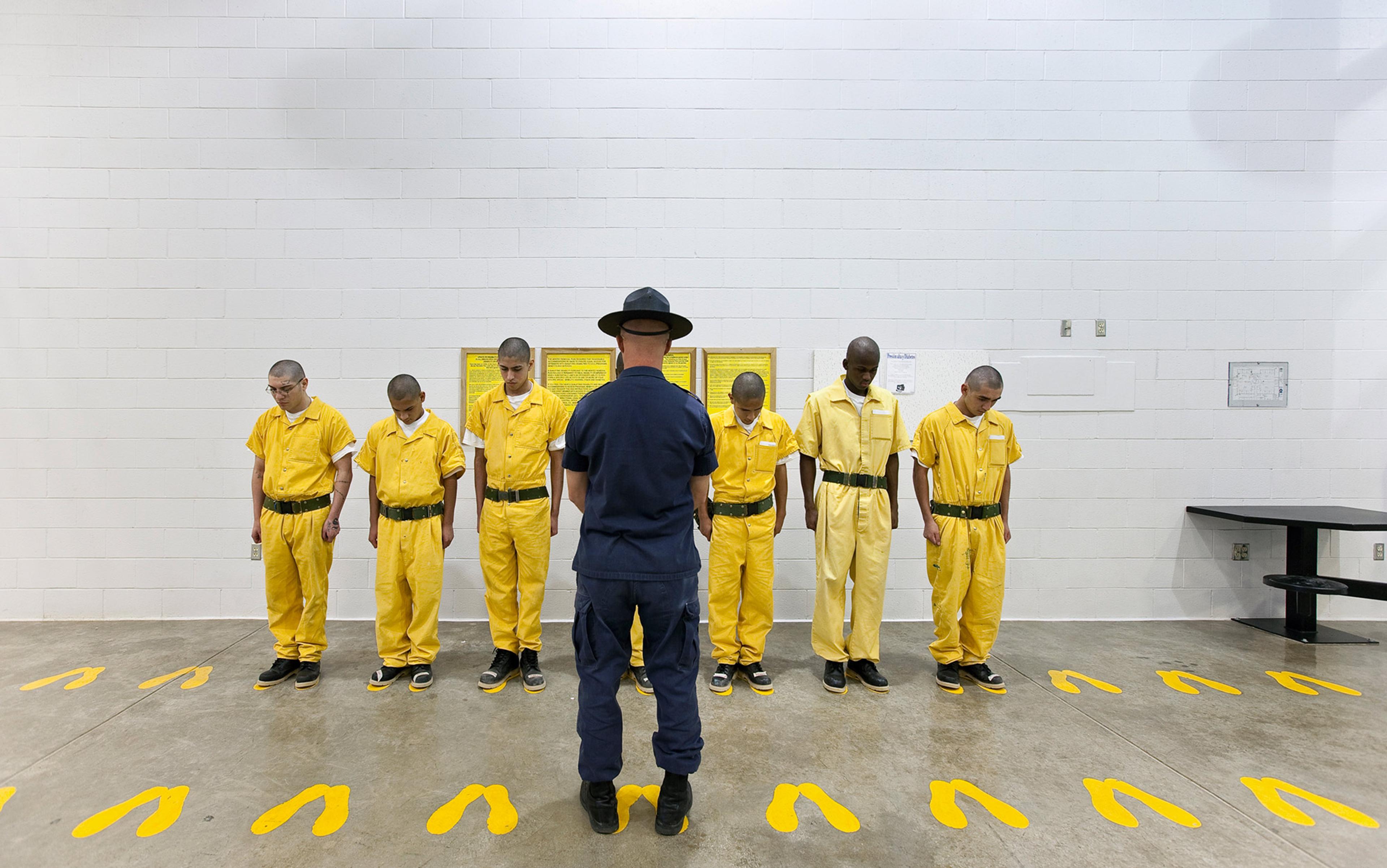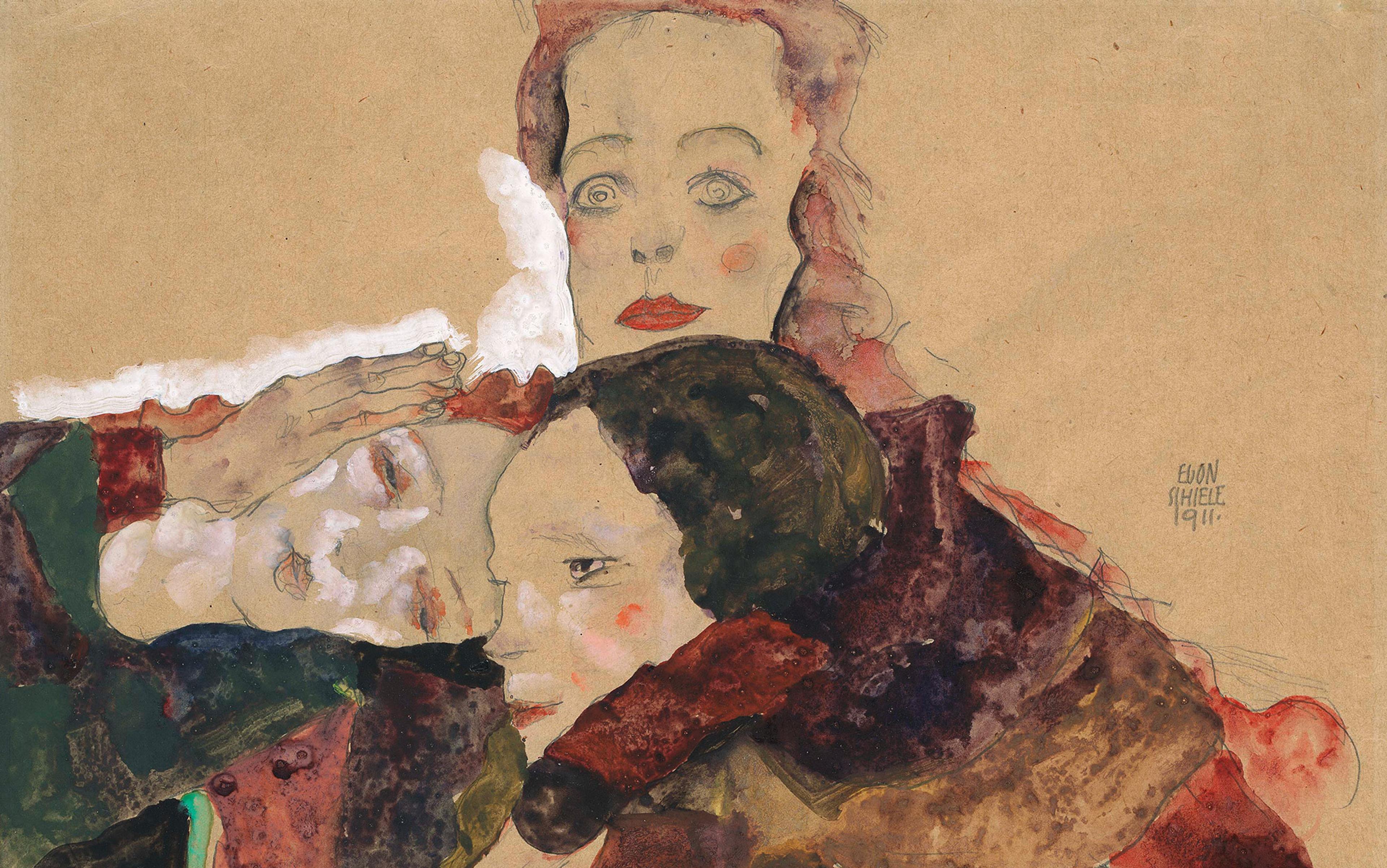… nationwide projects, prison-industry complex,
Working-class poor, better keep your alarm set
Streets too loud to ever hear freedom ring
Say evacuate your sleep, it’s dangerous to dream
For cha-ching, cats get the cha-POW – you dead now
Killing fields need blood to graze the cash cow
It’s a numbers game, but shit don’t add up somehow…
– From ‘Mathematics’ (1999) by Yasiin Bey, aka American rapper Mos Def
The 13 May was usually a happy day for Carolina Maria de Jesus. It’s a day of celebration in Brazil, especially for Black Brazilians, as it marks the date that slavery was abolished in 1888, making this the last country in the western hemisphere to do so. However, on that day in 1958, de Jesus didn’t have time to celebrate. It was cold, and the impoverished daughter of Brazilian sharecroppers had only beans and salt to feed herself and her children. She spent the day sending her children to plead with neighbours to share some lard so that she could make soup for her family. Or, to use her own explanation of her situation, she spent the day fighting slavery of a different sort – the ‘present-day slavery’ of hunger, and the constant struggle to avoid it.
The diary in which she wrote these words, Quarto de Despejo (1960) – literally ‘The Garbage Place’; published in English as Child of the Dark (1962) – broke barriers. It was the first bestselling work of literature by a Black Brazilian woman and to date one of the most prominent first-person accounts of life in favelas, Brazil’s notorious slum neighbourhoods. De Jesus grew up an outcast, one of two children born out of wedlock in a heavily Catholic section of rural Minas Gerais. When her mother died, she moved to the slums of the big city of São Paulo, where she built herself a house out of whatever suitable scraps she could find, and from where she wrote her diary. This diary makes vivid the structuring reality of dire material insecurity: where the hunger after a skipped meal and the cold that rips through worn-out clothes meet the worry of whether there’ll be food and shoes tomorrow. As she told it, these thoughts and concerns stood steadfastly between herself and freedom.
The 31 October of the same year was a happy day for a prominent contemporary of de Jesus’s: Isaiah Berlin became the Chichele Professor of Social and Political Theory at the University of Oxford when he delivered an inaugural address called ‘Two Concepts of Liberty’, which became a classic work of political philosophy. In the lecture he distinguishes between ‘positive’ and ‘negative’ liberty (typically used interchangeably with ‘freedom’). Negative liberty is freedom from interference, the absence of certain kinds of obstacle, restraint or coercion from other people. The paradigmatic form of negative freedom is freedom from the arbitrary will that a dominating master inserts between the enslaved person’s agential capacities and her desires. This conception is often preferred by political liberals and libertarians, who champion political rights and institutional procedures that aim to protect individual freedom from the encroachment of others – including (and, for some, especially) the state. Positive liberty, on the other hand, is ‘the freedom which consists in being one’s own master’: self-control, the ability to make choices and act upon them. Someone struggling with addiction might have negative liberty, since she could be free from others’ interferences, yet still be unfree in the positive sense if the addictive impulses overwhelm her capacity to decide for herself.
De Jesus’s way of thinking about freedom, implicit in her description of favela poverty, doesn’t obviously fit into either of Berlin’s ways of thinking about freedom: she neither describes her unfreedom as the imposition of any particular actor (as a failure of negative liberty) nor as a failure of rational self-control (as a failure of positive liberty).
It’s tempting to write off her description of material deprivation as slavery as a dramatic overstatement or rhetorical flourish. De Jesus, after all, was a complicated figure whose lifestyle didn’t conform to middle-class norms of respectability – she never married, and her three children had different fathers. Further complicating matters, her politics often diverged from the tidy progressivism that might otherwise have established her as a liberal or even a Left icon – she notably declines to call Brazil a racist country when given the opportunity, and her diaries describe her fellow favelados in critical terms. In contrast, Berlin was a person of the expected pedigree for philosophical thought: a named professor at one of the world’s most prestigious universities, who retains iconic status long after his death in 1997. Nevertheless, there’s another option: that de Jesus deliberately expressed a deep insight into the nature of freedom and what it requires, and that insight in itself might present a viable alternative to the account preferred by thinkers such as Berlin.
Characterising the difference between de Jesus and Berlin comes down to a subtle difference in subject matter. Both positive and negative liberty primarily relate the actions of the political subject to her desires and goals, and the different things that corrupt this relationship: on the negative version, the interference of other people in the pursuit of one’s own goals; on the positive version, the interference of unmanageable desires or aversions that can result in failures of rational self-mastery.
But perhaps this is one level of abstraction too low to meet the lofty point offered by de Jesus. After all, our desires and goals themselves are powerfully shaped and explained by our circumstances, and our preferences, plans and actions respond to these circumstances. Perhaps freedom, then, relates directly to our circumstances, and not just to the relationships between rational goals, action and social interactions that develop afterward. This is the thought that seems to be behind de Jesus’s suggestion that hunger itself made her unfree, rather than a particular story about why or whether she or others were to blame for her hunger.
De Jesus’s thinking about freedom is in good company with the wider history of a particular genre of philosophical thought known as ‘materialism’. Materialists have good reason to take security as seriously as de Jesus does: especially those aspects of social and economic life that concern our basic needs – that is, material security.
Political use of the term ‘security’ is often associated with surveillance and authoritarianism given the Right-wing politics that currently dominate discussion of this idea and its structuring role in our oppressive political order. But security itself – particularly with respect to basic material needs such as food, water, shelter, healthcare and protection from violence – is also one of freedom’s most important building blocks. This is clearer now than ever, as the fallout from COVID-19 adds hundreds of millions of people worldwide to the food-, housing- and water-insecure. The overlooked radical history of thought about this term demonstrates its promise for us in the present: a politics up to the task of fighting the fight for freedom in an increasingly precarious world.
De Jesus begins Quarto de Despejo with a diary entry for 15 July 1955, her daughter’s second birthday. De Jesus had hoped to buy Vera Eunice a pair of shoes but, she writes, ‘the price of food keeps us from realising our desires’. So de Jesus casts aside the desire to buy her daughter shoes, and instead finds a pair in the garbage and washes and patches them so they’re ready for her to wear. Later, she uses the few cruzeiros she earns from washing three bottles to buy bread.
No tyrant made her fish through the garbage in search of a birthday present. No individual or dictatorial army compelled her to buy the food. There’s no problem of negative liberty here. Neither is there of positive liberty: she doesn’t she feel an irresistible impulse to buy the food – she decides to, after sober reflection upon her circumstances and priorities. Yet de Jesus still chooses to describe her predicament in terms of slavery, writing ‘we are slaves to the cost of living’.
Materialism offers us some reasons for taking her literally. This view emphasises the connection between human society and the natural world. We are embodied creatures with biological imperatives and needs, and we are this before we’re anything else. Since economic production is how we make the things we use to meet our basic needs, perhaps we can start here to build our understanding of the social world.
Under capitalism, production is chiefly controlled by firms that owe their social role to their private ownership of the ‘means of production’. Paradigmatically, this has meant ownership of natural resources and factories (though today ownership of technology and intellectual property are rising in prominence). These firms are often understood as trying, above all, to maximise profit or value for shareholders. Since these firms are the movers and shakers of our global economy, it might stand to reason that our whole social system should be analysed in the same way: as primarily driven by profit-hungry elites and the decisions they make to maximise their and their co-conspirators’ wealth. This way of understanding things lends itself to a particular sort of explanation of historical events: the war in Iraq, policing and climate change are really problems driven by the same things that drive corporate behaviour: a desire to maximise profit and wealth for a shadowy corporate elite; the accumulation of capital.
This is too simple. An analysis that reduces everything to class neglects a broad array of social relations that are fundamental to explaining history, such as those related to race, gender, caste and ability. But, as Vanessa Wills notes in her lecture ‘What Could It Mean to Say, “Capitalism Causes Sexism and Racism?”’ (2018), the reason why the working class and its economically productive labour enjoy such centrality in Marxist thought (an important, though not the only, strain of materialist thought) is derivative of the role that production itself plays. In other words, Wills argues that Marxist thought is a production-centred view of society, not a class identity-centred view. Humans are creatures with biological needs, without which we will die – meaning that our pursuit of any other ends is causally dependent on our continued existence. This, in turn, causally depends on our activity to meet those basic needs. This set of activities – the things that must be done if anything else is to be done – is production.
But, important as it is, not everything we do is directly explained by the social need for production. Though mentioned by Karl Marx in Das Kapital, Volume I (1867), it was materialist feminists who best recognised the importance of social reproduction: the work done today to make sure production can happen tomorrow. This establishes a second important functional category besides production that we can use to explain more of our social world than we could by appeal to production alone.
With security in mind, it’s easier to see how focusing on the maximisation of profit and plunder gets things wrong
However, a third kind of social goal stands in the background of both production and reproduction. That goal is security. Both active interventions and the causal contribution of the environment itself help to cement the kind of social regime that ensures dependable returns to profitmaking activities, but also stable means for actions of any kind – and thus the possibility of acting freely. Marx noticed as much in his essay ‘On the Jewish Question’ (1843): ‘Security is the highest social concept of civil society … expressing the fact that the whole of society exists only in order to guarantee to each of its members the preservation of his person, his rights, and his property.’
Both production and reproduction, like most human activity, are extended processes: composed of parts that are extended across time, space and (crucially for the subject of freedom) persons. Each part of a process depends on the other parts both for justification and their basic constitution: that you’ll later eat the dinner I cooked for you both makes it good that I’m now cooking you a meal and makes it true that I cooked you a meal. Security is the glue that holds the parts of all processes together, productive or not, whether they take place under racial capitalism or some other mode of production.
With security in mind, it’s easier to see how focusing on the maximisation of profit and plunder gets things wrong. The anthropologist James C Scott makes the point well, if a bit specifically, in the preface to his study of South Asian peasant economies, The Moral Economy of the Peasant (1976): ‘The critical problem is not the average surplus extracted by elites but whose income is stabilised at the expense of whom.’
This way of thinking about security offers a different way in to well-worn debates in materialist thought. Take, for example, the long debate about ‘primitive accumulation’, a popular story about the instrumental role of the unfreedom of many for the profit of the few. One common approach describes primitive accumulation in stages, as a process. First, colonisers got control over the land and parcelled it into private property. This eliminates the possibility for non-elites to live off the land – which becomes ‘trespassing’ – thus eliminating the possibility that most people could provide for their own material security directly. This material insecurity forces people into the capitalist mode of production and sets the negotiating positions between them and the owners of the things used to meet one’s material needs: the capitalists. Some take it that the process repeats, with different characters or in different parts of the world.
There’s a different – and better – way of explaining the relationship between material insecurity and oppressive social structures. Let’s use the history of the United States as an example. Racial domination of the enslaved and Indigenous populations helped to secure the social order on which the tobacco and cotton plantations depended, in a scheme based on antagonistic security. That order was maintained by a comprehensive system of social policing, in which the conquering army or settler militia policed Indigenous peoples, and the overseer and slave-patrol policed the enslaved. These roles distributed risk in calculated ways that aimed at making society safe for the prestige- and profit-making activities of elites. For the people whose resistance would be most threatening to the social order, it was dangerous to use land, to use one’s own bodily autonomy, even to use one’s rational capacity (reading was often outlawed) due to the threat of militias and overseers.
Effectively setting and maintaining this distribution of risk made the colonisers’ social order possible. Settling the land and policing its labourers made it possible to grow cotton, as well as rational to reproduce the labour power whose very reason for existence was calibrated to this particular social structure. That is: the distribution of security and insecurity was constitutive of such societies, not simply an unhappy consequence of them. As Huey Newton, co-founder of the Black Panther Party, explained in 1968:
The police in our community couldn’t possibly be there to protect our property because we own no property. They couldn’t possibly be there to see that we receive due process of law for the simple reason that the police themselves deny us due process of law. And so it is very apparent that the police are only in our community not for our security but for the security of the business owners in our community, and so to see that the status quo is kept intact.
This distribution of security and insecurity is the source of de Jesus’s unfreedom.
What would it take for de Jesus to be free, on her terms? In The Unedited Diaries of Carolina Maria de Jesus (1999) – collected by Robert Levine and José Carlos Sebe Bom Meihy, and translated into English by Nancy Naro and Christina Mehrtens – she is asked by a journalist if there’s racial prejudice in Brazil. She answers ‘no’, saying that ‘the Black Brazilian has freedom to choose what he wants’ – positive liberty, in Berlin’s sense. Yet, in these very same unedited diaries she repeats the insights she expressed in her first book: that ‘a hundred years after abolition, Blacks are not free’ and that ‘I don’t know the taste of the whip. The only thing that enslaves me is the cost of living.’
We can assume that de Jesus is being careful in the interview: even though it takes place in 1961, before the military dictatorship of 1964-85, her social position as a Black favelada in Brazil’s high society is still quite precarious. But, as we’ve seen, we needn’t take her to be lying or confused, because the sense in which she believes that Blacks are still enslaved is entirely compatible with the senses of ‘freedom’ identified by Berlin. The slavery she discusses is neither the absence of negative freedom because of direct interference by whites nor the lack of positive freedom in the sense of being formally barred from particular actions by the system. Rather, it is the structuring effect that material insecurity has on her life, directly.
We can get further to understanding what security is and why it matters for a materialist analysis of oppression by considering a distinction in two ways of generating security. Antagonistic security is ‘security from’: parts of the system, people within it or well-positioned people’s interests are secured by way of directing precarity at others. This is the security that those within the barbed wire fence have with respect to those on the other side of it. It is also the mode of producing security built into racial capitalism, and likely the kind Marx imagines when he goes as far as to say that security is the very ‘concept of police’.
Collaborative security, on the other hand, is ‘security with’ – the kind of security produced by and held for all. This is the kind of security from infection enjoyed by a population with herd immunity, the security that the drainage system provides the town that lives atop of it. It’s also likely the version that the materialist thinker and anti-imperialist militant Amílcar Cabral had in mind when he argued in 1966 that national liberation required ‘liberation of the process of development of national productive forces’ – that is, secure popular control over them – and that that in turn involved breaking the cultural domination that secured imperial domination.
This distinction helps us make progress towards a kind of materialist position that is wider-scoping than the ‘class-reductionist’ sort, but no less rooted in materialist thought. This possibility is best exemplified by the geographer Ruth Wilson Gilmore, who defines racism this way in her book Golden Gulag (2007) on California’s prison system: ‘the state-sanctioned and/or extralegal production and exploitation of group-differentiated vulnerability to premature death’. Gilmore’s general insight on ‘premature death’ states plainly what meeting one’s material needs is about: staying alive, without which one can’t meet any other goals. It also observes, importantly, group-level differences in precarity with respect to this basic need. These differences in security are produced and exploited by the powerful or well-positioned, both within and outside the state.
Those empowered by the state to kill and to cage are doling out the most extreme forms of material insecurity
If Gilmore’s position on racism is a what, then Cedric Robinson’s provides a why and a how. Drawing on the sociologist Oliver Cox’s views on caste, class and race, Robinson explains a view known by the shorthand ‘racial capitalism’. In his book Black Marxism (2nd ed, 2000), he argues that European colonialism changed much more than how peoples across the globe produced goods. Capitalism, the system of production that resulted, came tethered to a wider set of social arrangements that tended to organise populations into sharp, vertical hierarchies. These were cemented and maintained by material relations of domination, and understood by ‘racialism’ – the values, intellectual habits and ‘traditions of consciousness’ that framed and legitimated the transition between old European forms of social organisation and the new global ones produced in the midst of colonial conquest and the resultant global trade.
Taken together, these offerings by Gilmore, Robinson and Cox cohere into a materialist conception of the global political reality created by European conquest. Given the contingent facts about how we built a global system, and who did the initial structuring, we now tend to see capitalism as a system of global production. The social system that secures this in place, and generates the security hierarchies that match the racial realities, evolved in path-dependent fashion from the particular one that was regionally dominant in the European countries that were ascendant when the structure was built. As a result, the global political system retains the basic social-structural characteristics of those who spread the capitalist economic system: a tendency to organise populations into clusters, to separate those clusters into vertical hierarchies, and to legitimate this stratification via racialist thought and practice.
The strata are often unstable over long periods of time because the criteria for membership, its legitimating myths and the methods by which hierarchy asserts itself often differ dramatically from century to century within regions, countries and even individual communities. But security offers us a much more dependable working hypothesis, and an explanation of it: that each racial stratum experiences different levels of insecurity. This arrangement persists because this very fact, in itself, contributes to the system’s stability over time.
Today, the primary distributors of insecurity include the military and the police – those empowered by the state to kill and to cage, doling out the most extreme forms of material insecurity. Behind them lies a massively diffuse network of collaborating institutions that interface with them. These tend to include the prisons, courts and intelligence agencies, but surprisingly also the schools and welfare centres.
It is not, however, the discrete actions of the actors in these various institutions that de Jesus identified as making her unfree. Rather, it was the distribution of insecurity itself, the emergent result of many temporally near and far acts of policing and deprivation, of eviction and of foreclosure, of selling and auctioning.
This distribution, and the institutions that create it, explain why ‘the cost of living’ makes buying Vera Eunice a pair of shoes for her birthday unsafe for de Jesus. The ‘cost of living’ is a constant theme in her writing, and the diary entries of Quarto de Despejo are filled with references to the amount of money secured from acquaintances or spent on items of food or, if possible, clothing. After all, any mistake made regarding money meant hunger and cold, even death. And this shows what choices she has the ‘positive freedom’ to exercise. Security, in this sense, has just as much to do with capitalism as profit.
A comprehensive response to de Jesus’s unfreedom requires not just a different system of production but a different system of security.
Although a newspaper published extracts of her diary in 1958, it wasn’t until 1960 that de Jesus started to received royalties for Quarto de Despejo, her first and only smash hit. Her second book, the novel Casa de Alvenaria (1961), or ‘Cinder Block House’, features a hopeful time in her life. De Jesus had enough money from royalties to eventually buy a small house just outside of São Paulo, marking a class shift for her, as she left the crushing poverty of the favelas for the high hopes of the secure Brazilian middle class. But it was not as secure as she’d hoped. Levine and Sebe Bom Meihy, the two researchers who tracked down her Unedited Diaries, found that her new neighbours had rejected her, and that de Jesus was ‘continually hounded’ by those looking to satisfy curiosities or receive financial help. However, they don’t identify any specific financial calamity that explains her tumble from the heights of the Brazilian middle class. I suspect that, if we could ask her, de Jesus would simply say ‘the cost of living’ and turn back to tending her chickens.
Today, measured by the concentration of wealth in its top 1 per cent, Brazil is the second most economically unequal country in the world (behind Qatar). That inequality is secured by one of the world’s most violent systems of policing. Parelheiros, where de Jesus bought a house in 1969, is also the place where, this summer, a military policeman stood on the neck of a 51-year-old Black woman, beat her unconscious and dragged her limp body across the street.
Brazil’s ruling elite is exceptional only in degree. In kind, they are like many of the rest of us: they can imagine securing social orders only antagonistically, since it’s the security method most prominent in our current social order, the one for which we have most precedent. This tendency exposes even justice-focused movements to unwitting collaboration with injustice and oppression.
The development of the system of mass incarceration and increasingly violent policing in the US is instructive. The 1960s and ’70s were also a radical moment in US history, spurred on by the draft-fuelled Vietnam war and the anticolonial movements post-Second World War. These movements helped to energise fights for justice in the US, including surges in racial justice, the Red Power movement against ongoing US settler colonialism, and feminist organising.
The historian Elizabeth Hinton recently argued in The New York Times that the seeds of mass incarceration were planted in the 1960s and ’70s in response to the period’s racial uprisings and unrest. The US president Lyndon Johnson convened the Kerner Commission in 1967 to find a solution to the national security problem that the ‘race riots’ represented in the context of Cold War competition over hearts, minds and social structures. The commission answered with a strategy rooted in collaborative security: US political and economic institutions should commit resources ‘sufficient to make a dramatic, visible impact on life in the urban Negro ghetto’. Instead, Johnson signed the first piece of national crime-control legislation into law, and massively invested in the groundwork for a federalised system of surveillance and police militarisation. Over the coming decades and administrations, this would congeal into a massive system of caging and police violence, securing the political aspirations of elites such as Johnson at the expense of the US racial underclass.
At the same time, developments in justice movements set their political trajectories on a collision course with state power. The feminist movement was attacking the patriarchy with renewed vigour, seizing on the issue of domestic violence. Grassroots activists across the country started up women’s shelters in the 1970s, but the realities of pursuing stable funding and security needs (from potentially violent ex-partners) prompted tough strategic and political questions about which compromises to make with the state. According to the legal scholar Aya Gruber’s book The Feminist War on Crime (2020), such ‘law enforcement’ had become ‘the centrepiece of feminist DV [domestic violence] activism’ within a decade of the onset of the wave of shelter construction.
By 2009, more than a third of US Black men without a high-school diploma were incarcerated
Meanwhile, the legal scholar James Forman Jr argues in Locking Up Our Own (2017) that Black communities experienced a crimewave over the 1960s and ’70s, spurred by drug trafficking: in the 1960s, of heroin; by the 1980s, of crack. While Black communities were most harmed by punitive policing, they were also most targeted by the crime that was invoked to legitimate it – putting desires for racial justice, like the desires for gender justice, in a complex strategic situation. Black politicians and civil society members explicitly advocated for more draconian policing and sentencing – and helped to deliver them.
Finally, the Ronald Reagan administration sought to win concessions for the conservative family rights movement that helped to put him in office as president. According to Gruber, Reagan’s Family Violence Task Force fit into a larger political trajectory gradually replacing welfare programmes’ goals of redistributive justice with the management and policing of private family responsibilities – including the imputed responsibility of abused women for failing to leave their abusive husbands. Haunted by the electoral success of a Republican Party fired up by the crimes committed by the convict Willie Horton on a weekend furlough, Democratic Party elites such as Chuck Schumer and Joe Biden doubled down on authoritarian policing and incarceration. As Biden put it to the Senate in 1994: ‘The liberal wing of the Democratic Party is now for 60 new death penalties … for 100,000 cops … for 125,000 new state prison cells.’
All told, the security interests of the state and segments of feminist, racial justice, victims’ rights and family rights movements converged powerfully on the bipartisan project of mass incarceration. For all of these, young, working-class Black and brown men were paradigm objects of fear (insecurity) in white supremacist and anti-Black social systems, as the philosopher Tommy J Curry explores in his book The Man-Not (2017). As such, Gruber and Curry separately argue that these young Black men and boys provided the perfect scapegoat for social ills – allowing the victims’ rights movement to combine forces with ‘carceral feminists’ and to pursue harsher prosecuting and policing practices.
It would be difficult to overstate how devastating were the consequences for Black communities in the US: the sociologists Bruce Western and Becky Pettit find that, by 2009, more than a third of US Black men without a high-school diploma were incarcerated, and 68 per cent of Black male high-school dropouts born since the 1970s have prison records. It is appropriate that the major offensives launched and sustained by the carceral turn have been described as ‘wars’ (the ‘War on Crime’, the ‘War on Drugs’) because they have wreaked the kind of havoc we typically see in the aftermath of interstate conflict. Demographers estimate that, in the US, there are only 83 Black men for every 100 Black women in the non-incarcerated population aged 25 to 54; for comparison, there were 88 French men for every 100 French women in the aftermath of the First World War, for which France had implemented a universal conscription policy that pressed 80 per cent of its 10 million men of ages 15-54 into compulsory service.
The resultant system of antagonistic security in the US weaponised the actual bodily insecurity faced by those on the nightstick end of the criminal justice system to secure the subjective, psychological security demanded by Black politicians, victims’ and family rights groups, and the feminist movement – at least, as defined by a critical mass of their carcerally oriented elites. Gruber notes that those who were neither well-behaved middle-class white women nor working-class and gang-affiliated Black or brown men – ie, who didn’t perfectly fit into either the Tracey Thurman or the Willie Horton symbolic paradigms – were caught in the crossfire. Women of colour got some of the worst of these trends, and their incarceration rates soared after policies mandating arrest in response to domestic violence calls to police (some studies find that women commit as much or more intimate partner violence as men, though the methodology and interpretation of these results has been subject to intense, decades-long debate).
It is important to note, as the historian Donna Murch does in her review of Michael Javen Fortner’s book Black Silent Majority (2015), that the question of who collaborated with whom is importantly different from the question of who is to ‘blame’ for the social realities that emerge from those collaborations. The state and ruling elites had material resources – and thus practical options – that racial and gender justice movements did not. Moreover, it is precisely this gap and leverage that explains the tensions of the strategic position in which affiliates of these movements found themselves.
But the point stands: the ways that we seek to secure ourselves can conspire against deeper and more complex articulations of our political commitments. However noble our intentions, racial capitalism tends to draw the ways we aspire to produce safety and stability into its antagonistic gravitational pull, splitting the world into secure winners and precarised losers. We might need another model entirely.
The basic materialist approach to history and politics starts from a concept of man as a material being, and begins explaining everything else about society from there. That puts important emphasis on the connection between the ‘natural world’ and human society. Historically, this has often meant a focus on how humans have appropriated natural resources to wage competitions for status and control among themselves. But as the compound crisis of climate change and COVID-19 accelerates, we should be humbled by the emphatic reassertion of nature’s own causal powers. There’s never been a better time to get back to basics.
We will find ourselves, much sooner than we think, asking basic questions about how we’re going to secure ourselves and our basic needs. Movements and developments in the natural world will be asking the questions, but our fate will be determined by our collective political answers. We have reasons to be sceptical about the kinds of answers our given power structures will produce, even in nominal ‘collaboration’ with justice movements. Such collaborations, like all other politics inside racial capitalism, tend to operate on the antagonistic security paradigm: securing those ‘inside’ the core of the collaborative structure from those outside it.
The deciding aspect of politics over the coming century will be whether or not popular movements can challenge the current elite stranglehold on who and what is secured in society when crisis strikes. The compound COVID-19 and climate crisis simply brings new stakes to the old question of how to fundamentally reshape a social system that is centrally organised around securing the profit, hierarchical prestige and physical safety of the few through the carceral, environmental and economic insecurity of the many. In this sense, then, new and promising labour strategies such as Bargaining for the Common Good have the same goals, at bottom, as the recent mobilisations against police violence.
Ruth Wilson Gilmore and James Kilgore writing in 2019 about their ‘first and foremost philosophical’ commitment to prison abolition, make plain the choices that elites have made in how and for whom to produce security, and the alternative ethos: ‘Locking people up does not provide adequate housing, proper mental health treatment or living wage jobs, nor does it make us safe in any other way.’ Gilmore, in particular, often sums up her principled position on prison abolition with a simple, profound adage: ‘where life is precious, life is precious’. Accepting the deep moral truth of this is just a first step: we need to build a society that functions like it. Such a society, and the way it would secure itself, would be fundamentally at odds with racial capitalism.
